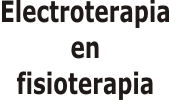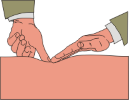 07/01/2026 13:49:24
07/01/2026 13:49:24
Automatic Spanish translation
Answer about the deep Oscillation technique
Question
"
I ask you this question because I want you to clarify some concepts
about the Deep Oscillation technique:
Can you explain to me why the hand vibrates on the patient?
Would you apply it to a pregnant woman?"Answer
In the Deep Oscillation technique, what is really applied is the potential difference (voltage) to a circuit that is basically formed by a capacitor. I explain:
A capacitor is made up of two conductive parts separated by an insulating layer. But it has the property that if you apply an electric charge to one of the conductive parts, even though there is an insulator between the two, the other conductive part is influenced to charge with the opposite polarity. It is the same condenser effect that is applied with the short wave, but in this case with very low frequencies.
In this technique, a conductive part of the capacitor is the therapist's hand. The other conductive part of the condenser is the tissue and skin of the patient under the hand. The insulator is the vinyl glove.
The therapist applies an electrode. Another is applied to the patient. The voltage rises (not the intensity) because the equipment works in VC or constant voltage. When the energy tries to circulate, it encounters the barrier of the glove, but on each side of the glove electrical charges of opposite signs [+] and [-] have accumulated, which do not pass from the therapist to the patient or vice versa; But be careful, they do exist in the areas close to the contact, within the patient and within the therapist.
I have made measurements of the intensity step using the practice box
plus the oscilloscope, and small peaks of energy step appear, but they
are insignificant. If the glove deteriorates, a current begins to
flow, the patient complains of the perception of some electrical
discomfort and proceeds to change to new gloves.
Why does this jumping movement occur?
Because the instant the pulse is applied, opposite electrical charges build up on both sides of the glove's vinyl layer (insulating layer). The electrical charges of opposite sign generate a physical attraction of the matter that contains them (in this case the hand of the therapist and the tissue of the patient under the hand).
At the moment of the pulse, the hand is drawn (loosely attached) to the patient. But at the moment of rest between the pulses it is freed to move more freely. A pulse comes and sticks. A rest comes, it is released. A pulse comes, sticks. A rest comes, it is released. So on at the frequency that is set on the equipment. If the hand remains still, that effect continues to exist but is not perceived.
The saltatory or vibratory displacement of the hand (or the head)
induces its corresponding mechanical vibration in the patient's
tissues, which will be more or less intense depending on the
difference in potential applied. The speed depends on the frequency.
About the "intensity adjustment", it occurs to me to tell you that it
is usually called intensity because we suffer from the vice that
everything is called intensity without knowing very well what it is
talking about, and "INTENSITY" is applied indiscriminately to
everything.
How is that intensity measured? In mA? Well no, because in this case
it does not exist and because the output voltage is actually
regulated, but this parameter is not shown and an imaginary value is
indicated within a range that has been established between 0
(minimum), and a maximum that It might be 10, maybe 5, maybe 3,
whatever the manufacturer comes up with. It can also be indicated in
percentages between 0 and the maximum.
The value of a range is actually indicated without a specific unit of measure. Is this good?
I would indicate what is actually regulated, which is the voltage, to avoid confusion and help clarify concepts of the technique. But if it is done in the form of SCALAR RANGE, it is necessary to explain at least the equivalences between each point on the scale and its value in volts.
In this technique we should not speak of mA because this parameter does not really appear between electrodes. But it would be very interesting to do intratissue measurements. For example: between the patient's skin and several centimeters deep.
With regard to applying it in pregnancy, if the treatment is on one arm (for example) and the patient's electrode is fixed on the same arm, why not? I do not find contraindications. Another thing would be if the patient's electrode is placed on one leg, or the lower back. In that case it would not proceed, because the electric field could affect the gestation area.
In conclusion: if the field of electrical influence is far from the
gestation area, I do not find a contraindication for this application.
But it often happens that excessive fear "of the unknown" makes us be
excessively cautious.
I hope I have resolved your doubts.
Posted on 02/31/2021







